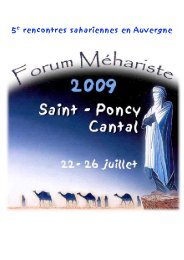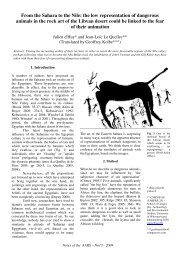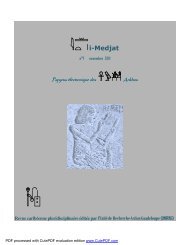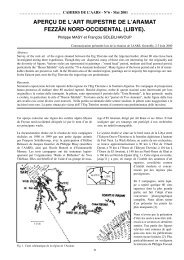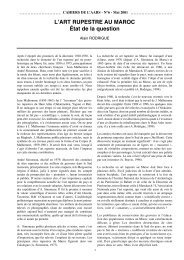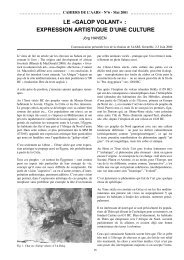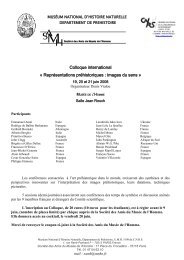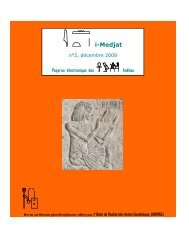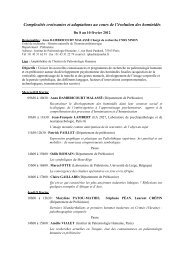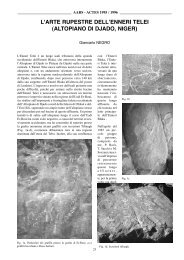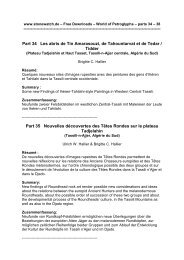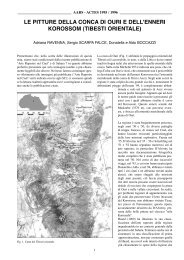lettre_ 29.pdf - Amis de l'Art rupestre saharien (AARS)
lettre_ 29.pdf - Amis de l'Art rupestre saharien (AARS)
lettre_ 29.pdf - Amis de l'Art rupestre saharien (AARS)
Create successful ePaper yourself
Turn your PDF publications into a flip-book with our unique Google optimized e-Paper software.
La Lettre <strong>de</strong> l’<strong>AARS</strong>, No. 29 (2006)<br />
Éditorial<br />
Dear friends,<br />
Saharan rock art is in the spotlight,<br />
but for bad reasons. On Dec 14, the Perpignan<br />
customs services seized 124 archaeological<br />
objects from Morocco, in a<br />
vehicle on its way back to Italia. These<br />
stolen artefacts inclu<strong>de</strong>d stone pendants,<br />
arrow-heads, beads, polished stone axes,<br />
grinding stones, pestles, and… rock<br />
engravings (see pictures on the right).<br />
Three of these rock art pieces have been<br />
cutted very recently (as shown by patina),<br />
obviously to be “exported” and<br />
sold in Europe. One of them was broken<br />
during extraction and has been roughly<br />
repaired.Another one (a beautiful Bovid<br />
ingraved in the Tazina style) looks like<br />
having been extracted long ago: it could<br />
have been taken from an old collection<br />
(perhaps a small provincial museum ?).<br />
The Moroccan Ministry of Culture, in<br />
collaboration with the Ministry of Foreign<br />
Affairs and Cooperation, said it<br />
would take the necessary measures to<br />
recuperate these stolen archaeological<br />
objects. The case will be put on trial in<br />
Sommaire<br />
Editorial......................................... .................. 1<br />
lEs rEncontrEs dE l’aars............................... 2<br />
cartE / Map...................................................... 3<br />
listE dEs hôtEls dE Joigny / hotEls in Joigny.... 4<br />
aars MEEting at Joigny.................................. 5<br />
tablEs d’hôtEs à Joigny / b&b at Joigny.......... 5<br />
La <strong>lettre</strong> <strong>de</strong> l’<strong>AARS</strong><br />
No. 29 Association <strong>de</strong>s <strong>Amis</strong> <strong>de</strong> l’Art Rupestre Saharien<br />
June, and no doubt the smuggler will be<br />
heavily fined. Till then, if you recognize<br />
any of these engravings because you<br />
have previously seen them on the original<br />
spot or in a publication, please don’t<br />
hesitate to contact me, in or<strong>de</strong>r to transmit<br />
this information to the concerned<br />
authorities.<br />
Thanks in advance, and all the best,<br />
JLLQ<br />
Chers amis<br />
L’art <strong>rupestre</strong> <strong>saharien</strong> est sous les<br />
projecteurs, mais pour <strong>de</strong> mauvaises<br />
raisons. Le 14 décembre <strong>de</strong>rnier, les<br />
douanes <strong>de</strong> Perpignan ont saisi 124 pièces<br />
archéologiques en provenance du<br />
Maroc, dans un véhicule qui retournait<br />
en Italie. Parmi les objets volés figuraient<br />
<strong>de</strong>s pen<strong>de</strong>ntifs <strong>de</strong> pierre, <strong>de</strong>s têtes<br />
<strong>de</strong> flèche, <strong>de</strong>s perles, <strong>de</strong>s haches polies,<br />
<strong>de</strong>s meules, <strong>de</strong>s pilons et… <strong>de</strong>s gravures<br />
<strong>rupestre</strong>s. Trois <strong>de</strong> ces <strong>de</strong>rnières ont<br />
été détachées très récemment <strong>de</strong> leur<br />
support (comme le montre la patine),<br />
à l’évi<strong>de</strong>nce pour être “exportées” et<br />
vendues en Europe. L’une d’elle a été<br />
Telisaghen : le site <strong>de</strong> l’Apollon garamante<br />
cassée durant l’extraction, et a subi une<br />
réparation grossière. Une autre (un beau<br />
boviné <strong>de</strong> style Tazina) semble avoir été<br />
extraite il y a longtemps: elle pourrait<br />
bien avoir été dérobée dans une collection<br />
ancienne (peut-être un petit musée<br />
<strong>de</strong> province?). Les ministres marocains<br />
<strong>de</strong> la culture et <strong>de</strong>s affaires étrangères<br />
ont dit que le nécessaire serait fait pour<br />
récupérer ces objets volés. Le procès<br />
se tiendra début juin, et il ne fait aucun<br />
doute que le passeur sera lour<strong>de</strong>ment<br />
pénalisé. En attendant, si vous reconnaissez<br />
l’une ou l’autre <strong>de</strong> ces gravures<br />
parce que vous l’auriez déjà vue sur son<br />
site d’origine ou grâce à une publication<br />
ancienne, n’hésitez pas à me contacter,<br />
pour que nous transmettions cette information<br />
aux autorités concernées.<br />
Merci d’avance,<br />
et cordialement à tous,<br />
JLLQ<br />
sahara hints / cEnni sahariani (l. dE cola).. 6-7<br />
thE fatE of a dEcoratEd MEnhir (M. Milburn).. 8<br />
christian and haoussa crossEs (M. Milburn) .... 8<br />
dEbats / dEbatEs (a. rodriguE)......................... 9<br />
nouvEllEs / nEws (JllQ)............................... 9<br />
Reconnaissez-vous ces gravures<br />
<strong>rupestre</strong>s dérobées au Maroc ?<br />
Do you Sommaire<br />
recognize these stolen<br />
Moroccan engravings ?<br />
Si oui, merci <strong>de</strong> contacter :<br />
If so, please contact :<br />
<strong>rupestre</strong>s@club.fr
La Lettre <strong>de</strong> l’<strong>AARS</strong>, No. 29 (2006)<br />
Community Life — Vie assoCiatiVe<br />
Les rencontres <strong>de</strong><br />
l’<strong>AARS</strong> 2006<br />
Les prochaines rencontres <strong>de</strong> l’<strong>AARS</strong><br />
se tiendront à Joigny dans l’Yonne<br />
(France), du 25 au 27 mai 2006.<br />
La municipalité <strong>de</strong> Joigny met à notre<br />
disposition une salle bien équipée et<br />
très spacieuse. Nous pourrons disposer<br />
<strong>de</strong> toute la place nécessaire pour réaliser<br />
une petite exposition sécurisée <strong>de</strong>s<br />
artistes <strong>saharien</strong>s.<br />
Nous aurons également un projecteur<br />
vidéo, un projecteur diapo et un rétroprojecteur.<br />
Le programme provisoire est le suivant:<br />
Jeudi 25<br />
16h30 - 18h30 — Réunion <strong>de</strong> bureau à<br />
l’hôtel Rive Gauche (qui vous est chaleureusement<br />
recommandé : il est situé<br />
à cinq - dix minutes à pied <strong>de</strong> notre lieu<br />
<strong>de</strong> réunion, et il dispose d’un Parking<br />
fermé. En vous présentant, n’oubliez pas<br />
<strong>de</strong> dire que vous venez pour la réunion<br />
<strong>de</strong> l’<strong>AARS</strong>. Pour notre dîner du soir, cet<br />
hôtel peut aussi assurer la restauration à<br />
condition <strong>de</strong> fixer un ordre <strong>de</strong> nombre<br />
<strong>de</strong> personne (entre 20 et 30 personnes à<br />
confirmer). Prix du dîner 24,5 € sans les<br />
boissons. Notez qu’il existe un camping<br />
municipal (tel. 0386620755).<br />
Vendredi 26<br />
9 h00 - 9h30 — Ouverture <strong>de</strong> la réunion,<br />
premières présentations.<br />
12H00 - 14h00 — Déjeuner<br />
14h00 - 17h00 — Suite <strong>de</strong>s présentations.<br />
17h30 - 19h00 — Assemblée <strong>de</strong><br />
l’<strong>AARS</strong>.<br />
19h00 - 21H00 — Dîner.<br />
Samedi 27<br />
9h00 - 9h300 —Suite <strong>de</strong>s présentations.<br />
12h00 - 14h00 —Déjeuner.<br />
14h00 - 1600 — Suite <strong>de</strong>s présentations<br />
et clôture <strong>de</strong> la réunion.<br />
16h30 - 18h00 — Réunion <strong>de</strong> bureau<br />
et/ou du comité d’édition du Cahier<br />
en hommage à Alfred Muzzolini.<br />
19h00 — Dîner <strong>de</strong> clôture.<br />
Dimanche 28<br />
Si <strong>de</strong>s membres sont intéressés, nous<br />
pouvons solliciter l’organisation d’une<br />
visite aux grottes d’Arcy-sur-Cure qui<br />
se trouvent à une petite heure <strong>de</strong> Joigny<br />
(voir plan ci-joint) mais il faut prévoir<br />
exactement le nombre <strong>de</strong> personnes et<br />
en faire la <strong>de</strong>man<strong>de</strong> à l’avance.<br />
Les personnes envisageant <strong>de</strong> présenter une<br />
communication lors <strong>de</strong>s rencontres sont<br />
priées <strong>de</strong> bien vouloir en avertir le prési<strong>de</strong>nt<br />
et d’envoyer le titre <strong>de</strong> leur intervention à<br />
l’adresse électronique suivante:<br />
<strong>rupestre</strong>s@club.fr<br />
Sur une suggestion <strong>de</strong> Jacqueline Friquet, Les membres <strong>de</strong><br />
l’<strong>AARS</strong> qui réalisent <strong>de</strong>s carnets <strong>de</strong> voyage, <strong>de</strong>s aquarelles,<br />
<strong>de</strong>s peintures ou <strong>de</strong>s <strong>de</strong>ssins ayant trait au Sahara peuvent<br />
les apporter, et une petite exposition pourra être organisée<br />
(en toute sécurité) dans la salle <strong>de</strong> réunion <strong>de</strong> Joigny.<br />
Apportez <strong>de</strong> préférence vos œuvres déjà montées ou collées<br />
sur <strong>de</strong>s supports pouvant être accrochés facilement.<br />
If you intend to present a communication<br />
at our meeting, please send an email<br />
with the title of your presentation<br />
to the following address :<br />
<strong>rupestre</strong>s@club.fr
La Lettre <strong>de</strong> l’<strong>AARS</strong>, No. 29 (2006)<br />
Vita ASSociATiVA — ASSoziATiVeS Leben<br />
Rencontres <strong>de</strong> l’<strong>AARS</strong><br />
<strong>AARS</strong> Meeting<br />
Hauptversammlung von <strong>AARS</strong><br />
Riunione <strong>de</strong>ll’<strong>AARS</strong><br />
As suggested by Jacqueline Friquet, our members<br />
who use to make paintings, drawings or sketchbooks<br />
during their travels in the Sahara are kindly<br />
requested to bring their work, in or<strong>de</strong>r to organize a<br />
small exhibition in the meeting hall at Joigny. Please<br />
bring by preference pieces already mounted on some<br />
framework that could be easily hung on the boards.
La Lettre <strong>de</strong> l’<strong>AARS</strong>, No. 29 (2006)<br />
Community Life — Vie assoCiatiVe<br />
Liste <strong>de</strong>s Hôtels <strong>de</strong> Joigny<br />
Hotels in Joigny<br />
Nom - Name Categ. Adresse - Address Tel. €<br />
Aux environs — In the surroundings<br />
Vous pouvez aussi contacter l’Office <strong>de</strong> tourisme :<br />
You can also contact the Tourist Home :<br />
Tel.: 0033 (0)3 86 62 11 05 — e-mail: ot.joigny@wanadoo.fr
La Lettre <strong>de</strong> l’<strong>AARS</strong>, No. 29 (2006)<br />
Vita ASSociATiVA — ASSoziATiVeS Leben<br />
Chambres d’hôtes à Joigny et aux alentours<br />
B&B in Joigny and surroundings<br />
Nom - Name Categ. Adresse - Address Tel.<br />
<strong>AARS</strong> Meeting 2006<br />
Our next meeting will be held at<br />
Joigny (Yonne) in France, from May<br />
25 to 27. In Joigny, the municipality<br />
offers a large convention hall with all<br />
the requested necessities and a good<br />
equipment : sli<strong>de</strong> projector, vi<strong>de</strong>o-projector<br />
and overhead projector. We’ll<br />
have enough room to organize a small<br />
exhibit with the works of our Saharan<br />
artists (so don’t hesitate to come with<br />
your watercolors, sketch-books, paintings<br />
or drawings…).<br />
This is the provisional programm:<br />
Thursday, 25<br />
16h30 - 18h30 — Meeting of the<br />
<strong>AARS</strong> bureau in the “Rive Gauche”<br />
Hotel (see maps and charts). By the<br />
way, this hotel is heartily recommen<strong>de</strong>d<br />
to our members; it is only at five<br />
to ten minute walk from the meeting<br />
place, and it has a closed parking lot.<br />
Do not forget to tell them that you<br />
are coming for the <strong>AARS</strong> meeting.<br />
Please also note that there is a municipal<br />
campsite (tel. 03 86 62 07 55).<br />
For our supper, this hotel can also propose<br />
the catering, provi<strong>de</strong>d we confirm<br />
in advance and give them the number<br />
of guests (about 20 to 30). Price for the<br />
supper: 25.5 €, wine not inclu<strong>de</strong>d.<br />
Friday, 26<br />
9h00 - 9h30 — Opening, first presentations.<br />
12H00 - 14h00 — Lunch.<br />
14h00 - 17h00 — Présentations.<br />
17h30 - 19h00 — <strong>AARS</strong> General<br />
Meeting.<br />
19h00 - 21H00 — Dîner.<br />
Saturday, 27<br />
9h00 - 9h300 — Présentations.<br />
12h00 - 14h00 — Lunch.<br />
14h00 - 1600 — Présentations; end of<br />
the meeting.<br />
16h30 - 18h00 — Meeting of the<br />
<strong>AARS</strong> Bureau and/or of the editing<br />
comitee for the book in honor of Alfred<br />
Muzzolini.<br />
19h00 — Closing supper.<br />
Sunday, 28<br />
If some members are interested, we<br />
can or<strong>de</strong>r a tour to the Arcy-sur-Cure<br />
caves, at about one hour of Joigny. But<br />
we’ll have to know very precisely how<br />
much people are interested, because we<br />
must or<strong>de</strong>r in advance.
La Lettre <strong>de</strong> l’<strong>AARS</strong>, No. 29 (2006)<br />
SAhARA hinTS — noTATionS SAhARienneS<br />
Sahara Hints<br />
Notations Sahariennes<br />
Hinweise zur Sahara<br />
From protohistory up to 1965<br />
De la protohistoire à 1965<br />
Von <strong>de</strong>r Vorgeshichte zu 1965<br />
A cura di Lorenzo De Cola<br />
<strong>de</strong>cola.lorenzo@tiscali.it<br />
L. Robecchi brichetti, All’oasi<br />
di Giove Ammone. Viaggio di<br />
L.Robecchi Bricchetti con<br />
incisioni e una gran<strong>de</strong> carta geografica,<br />
Milano, fratelli treves<br />
editori 1890.<br />
Libro importante per vari aspetti:<br />
le informazioni sul suo viaggio<br />
a Siwa nell’estate <strong>de</strong>l 1886<br />
(dopo un soggiorno di un anno in<br />
Egitto) sono preziose perché raccolte<br />
nel momento in cui le tradizioni<br />
erano osservate e ciò che<br />
Brichetti ve<strong>de</strong>va nell’interno <strong>de</strong>l<br />
paese erano comportamenti non<br />
influenzati dai costumi europei.<br />
I numerosi racconti che gli<br />
vennero fatti dai nomadi e dagli<br />
abitanti <strong>de</strong>lle oasi hanno una<br />
freschezza e una precisione notevoli.<br />
Le osservazioni su aspetti<br />
<strong>de</strong>lla vita materiale sono a volte<br />
audaci, sempre acute, e riportano<br />
<strong>de</strong>ttagliatamente circostanze interessanti.<br />
Le due grandi cisterne<br />
sotterranee menzionate lungo<br />
l’itinerario: Bir Abu Batta e Bir<br />
Airam non sono mai più state trovate<br />
(Lorenzo De Cola)<br />
In many respects an important<br />
book: the information about<br />
his journey to Siwa during the<br />
summer of 1886 is precious because<br />
gathered when the traditions<br />
were maintained and what<br />
Brichetti could see in the inland<br />
were behaves not influenced by<br />
European customs. The many<br />
tales the nomads and the inhabitants<br />
of the oasis told him have a<br />
noteworthy freshness and precision.<br />
The remarks concerning aspects<br />
of everyday’s material life<br />
are sometimes audacious; always<br />
perspicuous and report in <strong>de</strong>tail<br />
interestings circumstances.<br />
The two large un<strong>de</strong>rground<br />
cisterns mentioned along the voyage:<br />
Bir Abu Batta and Bir Airam<br />
have never been found again (all<br />
the following translation: Lorenzo<br />
De Cola)<br />
Pagina 32 — qualche <strong>de</strong>cina di<br />
Km a E di Alessandria (1) – “Il<br />
poco terreno che coltivano durante<br />
la stagione <strong>de</strong>lle piogge,viene<br />
seminato ad orzo ed a frumento.<br />
Solcano la terra con un aratro che<br />
quasi si può dire TASCABILE,<br />
composto di tre legni: uno che<br />
costituisce la stiva, l’altro cui si<br />
attacca l’animale che è un somaro,<br />
ed il terzo che ha all’estremità<br />
una punta di ferro che è un vomero.<br />
I solchi sono proporzionati a<br />
questo strumento. che raspa appena<br />
la terra e che è guidato da un<br />
beduino con una sola mano.<br />
E’ quell’aratro me<strong>de</strong>simo che<br />
si ve<strong>de</strong> raffigurato negli antichi<br />
monumenti egiziani, particolarmente<br />
nei simulacri di Osiri<strong>de</strong>,<br />
che in una mano ha il flagello, e<br />
nell’altra questo arnese, qualificato<br />
da Kircher per un monogramma<br />
esprimente l’Agatos Demon.<br />
Page 32 — some tenth of Km E<br />
of Alexandria “The few land they<br />
farm during the rainy season, is<br />
sewed with barley and wheat.<br />
They plough the earth with a<br />
plough that can be <strong>de</strong>fined a pocket<br />
type, composed by three woods:onebeingthe…verticalbar….,<br />
the other to which they hitch the<br />
animal that is a donkey, and the<br />
third that has to its extremity an<br />
iron point which is a ploughshare.<br />
The furrows are proportioned to<br />
this instrument that just scratches<br />
the earth and that is lea<strong>de</strong>d by a<br />
Bedouin just by one hand.<br />
It is that same plow that is represented<br />
in the ancient Egyptian<br />
monuments, particularly in the<br />
portrayal of Osyris, that in one<br />
hand has the scourge, and in the<br />
other this tool, qualified by Kircher<br />
as a monogram expressing<br />
the Agatos Demon.”<br />
Pagina. 76 — “I beduini Ualad-<br />
Ali ed i Senagrah, nonché tutti gli<br />
arabi <strong>de</strong>l <strong>de</strong>serto, hanno da tempo<br />
immemorabile l’abitudine di distinguere<br />
le loro tribù con segni<br />
particolari e caratteristici che li<br />
distinguono da tribù a tribu, e da<br />
famiglia a famiglia.<br />
I loro gregge, e particolarmente<br />
di cammelli ne portano l’impronta<br />
che serve a riconoscerli subito e<br />
distinguerli dalle tribù vicine.<br />
Però quando la tribù è formata<br />
da una gran<strong>de</strong> quantità di persone,<br />
si aggiungono a questo segno caratteristico,<br />
<strong>de</strong>lle piccole striature<br />
od accessori che servono a distinguere<br />
le grandi famiglie ecc.<br />
…solamente l’occhio attento <strong>de</strong>l<br />
beduino riesce a leggerle subito<br />
anche se sono modificazioni molto<br />
leggere.”<br />
Sono elencati alcuni segni di<br />
marchiature effettuati sia lungo<br />
le coste <strong>de</strong>lla Marmarica, sia<br />
anche in alcune parti <strong>de</strong>l centro<br />
<strong>de</strong>l <strong>de</strong>serto libico. I beduini di<br />
queste regioni quando viaggiano<br />
o pascolano i cammelli tracciano<br />
questi segni sui muri <strong>de</strong>lle tombe,<br />
sulle roccie e sui mucchi di pietre<br />
nel <strong>de</strong>serto. “Presso la tribu<br />
<strong>de</strong>i Zenagra il segno r con il t<br />
accompagnato da uno o più tratti<br />
orizzontali P o perpendicolari<br />
l o inclinati . si riproduce<br />
sovente.”<br />
Page 76 — “The Bedouins Ulad-<br />
Ali and the Senagrah, as well as<br />
all the Arabs of the <strong>de</strong>sert, have<br />
from time immemorial the habit<br />
of distinguishing their tribe with<br />
particularandcharacteristicmarks<br />
which set apart from tribe to tribe<br />
and from family to family.<br />
Their herds, and particularly<br />
camel herds, have marks that<br />
help to i<strong>de</strong>ntify them quickly and<br />
distinguish them from the close<br />
tribes.<br />
But when the tribe is composed<br />
by a great number of people, to<br />
this characteristic mark are ad<strong>de</strong>d<br />
small streaks or accessories<br />
that allow to distinguish the large<br />
families etc. …Only the attentive<br />
gaze of the Bedouin can read<br />
them at once even as the changes<br />
are very light ones.”<br />
Some signs utilized either<br />
along the coasts of the Marmarica<br />
or also in some parts of the centre<br />
of the Lybic <strong>de</strong>sert are listed .The<br />
Bedouins of these regions, when<br />
travelling or grazing the camels,<br />
carve these marks on the walls of<br />
the tombs, on the rocks or on the<br />
stone heaps in the <strong>de</strong>sert.<br />
“Among the Zenagra tribe the<br />
mark r with the t in conjunction<br />
with one or more horizontal<br />
marks P or perpendiculars l or<br />
inclined . is frequently reproduced.”<br />
Pagina 83 — “La storia <strong>de</strong>lla<br />
Libia ci dice che i popoli erano<br />
pastori (1) e perciò si nutrivano di<br />
latte e carne, eccettuata quella di<br />
vacca e di porco.<br />
Si coprivano con pelli di animali,<br />
la testa <strong>de</strong>i quali serviva<br />
loro da elmo, portavano scudi di<br />
diverse forma e combattevano<br />
con bastoni inarsicciati (induriti<br />
dal fuoco) in punta.”<br />
Page 83 — “The history of lybia<br />
informs us that the peoples (inhabitants)<br />
were sheperds (1) and<br />
therefore fed on meat and milk,<br />
except that of cow and pig.<br />
They covered themselves with<br />
skins of animals, the head of<br />
these animals served as helmet,<br />
bearing shields of different form<br />
and fighting with clubs that had<br />
the point har<strong>de</strong>ned by fire.”<br />
Pagina 138 — oasi di Garah “<br />
E’ tradizione a Gharah – ed è<br />
davvero una curiosa e singolare<br />
tradizione – che il numero <strong>de</strong>gli<br />
uomini nel fiore <strong>de</strong>ll’età non possa<br />
essere più di quattordici poiché<br />
infallibilmente il quindicesimo<br />
morirebbe.”
La Lettre <strong>de</strong> l’<strong>AARS</strong>, No. 29 (2006)<br />
cenni SAhARiAni — hinweiSe zuR SAhARA<br />
Page 138 — oasis of Garah. “ At<br />
Garah it is tradition - and in<strong>de</strong>ed<br />
it is a curious and peculiar one<br />
– that the number of men in their<br />
prime of life might not exceed the<br />
number of fourteen because unerringly<br />
the fifteenth would die.”<br />
Pagina 224 — (dal testo si capisce<br />
che fino a pochi anni prima)<br />
le donne in alcune occasioni praticavano<br />
culti priapici, mentre le<br />
donne sterili ricorrono tuttora a<br />
processioni in cui…” portano falli<br />
mossi con una cordicella. Altre si<br />
adornano il collo con questo emblema<br />
inciso in legno, o fatto di<br />
terracotta screziata, come amuleto<br />
contro il cattivo genio <strong>de</strong>lla sterilità.”<br />
Page 224 — (from the text it can<br />
be <strong>de</strong>duced that up to some years<br />
before)the women in some occasion<br />
performed priapic cults,<br />
whereasthesterilewomenstillhave<br />
recourse to processions during<br />
which “ they wear phalluses moved<br />
by a rope. Others adorn themselves<br />
with this emblem carved in wood,<br />
or ma<strong>de</strong> with flecked terracotta, as<br />
an amulet against the evil genius of<br />
sterility.”<br />
Pagina 225 — …”un’altra strana<br />
originalità si è che i vedovi, che,<br />
come dissi, abitano in un apposito<br />
quartiere nell’oasi di Siuwah (villaggio<br />
<strong>de</strong>l Menscihe), portano incisi<br />
sul proprio cranio i fasti (letteralmente<br />
“i fatti onorevoli” ma<br />
in questo contesto si tratta di performances<br />
amatorie) più o meno<br />
celebri <strong>de</strong>lle proprie mogli….<br />
E’ una cosa che colpisce il ve<strong>de</strong>re<br />
quelle teste bizzarre, che<br />
rammentano con vari ghirigori di<br />
figure scarabocchiate alla meglio,<br />
le peripezie coniugali, le vicen<strong>de</strong><br />
domestiche più intime, i segreti<br />
<strong>de</strong>l talamo sciorinati sulla fronte<br />
e sulle parti posteriori di un povero<br />
vedovo. Ne ho conosciuto<br />
uno che non potendo dimenticare<br />
la propria consorte si fece tatuare<br />
e dipingere sulle parti genitali e<br />
posteriori la storia <strong>de</strong>lle ebbrezze<br />
godute con la propria metà e i<br />
fasti più salienti <strong>de</strong>lla epoca coniugale.<br />
Page 225 — ”another strange<br />
oddity is that the widowers, that,<br />
as I mentioned dwell in a specific<br />
quarter in the oasis of Siuwah<br />
(the villane of Mensciche) have<br />
carved on their skull the fasts (literarily<br />
the” honourable facts”,<br />
but in this context we <strong>de</strong>al with<br />
love performances) more or less<br />
famous of their wives…”<br />
It is shocking to watch those<br />
odds heads, that recall with various<br />
squibbles of figures scribbled<br />
as best as they might, the conjugal<br />
vicissitu<strong>de</strong>s, the more intimate<br />
household events, the secrets of<br />
the thalamus showed off on the<br />
front and on the back parts of a<br />
poorwidower.Imetonethatbeing<br />
not able to forget his spouse had<br />
himself tattoed and painted on the<br />
genital and back parts the story of<br />
the thrill <strong>de</strong>lighted with his better<br />
half and the more prominent fasts<br />
of his conjugal epoch.”<br />
Pagina 287 — come tutti i Mussulmani<br />
i Sivioti non portano il<br />
lutto, ad eccezione di<br />
Alcuni individui “soprattutto<br />
fra le tribù <strong>de</strong>i Lifajah (l’etniadi<br />
Siwa ritenuta aborigena ), che in<br />
segno di lutto dipingesi le braccia<br />
di color azzurro o bruno e non<br />
se le lava più finchè quei colori<br />
rimangono, mentre le donne,<br />
quando muoiono i loro mariti,<br />
(questa usanza <strong>de</strong>lle mogli Lifaja<br />
sembra essere più diffusa) tingonsi<br />
d’indaco e si lasciano per<br />
qualche tempo ca<strong>de</strong>re in disordine<br />
le chiome, ed usano rivoltare<br />
in senso inverso le stuoie, i tappeti<br />
e i cuscini e tutto ciò di cui<br />
possono disporre.”<br />
Page 287 — Like all of the Muslims<br />
the inhabitants of Siwa do<br />
not go into mourning, except<br />
for some men “moreover in the<br />
tribes of Lifajah (the ethnic group<br />
of Siwa believed to be the aborigen<br />
one), that in or<strong>de</strong>r to show<br />
their mourning paint their arms of<br />
blue or dark brown colour and do<br />
not wash them until those colours<br />
last, whereas the women, when<br />
their husbands die (this custom of<br />
Lifajah wifes seems to be more<br />
diffused) dye themselves of indigo<br />
and let for some period their<br />
hair not ii or<strong>de</strong>r, and are used to<br />
turn upsi<strong>de</strong> down the mats (rugs),<br />
the carpets and the pillows and all<br />
of the stuff they can dispose of”.<br />
Pagina 287 —Riassunto :quando<br />
un siwano muore si avvisano al-<br />
cune donne vecchie ed esperte<br />
che lavano il cadavere e lo spazzolano<br />
con fili di foglie di datteri.<br />
Inoltre i corpi non vengono sotterrati<br />
ma sopra i corpi (affiancati)<br />
si pongono pietre. Vengono<br />
poi spostate le ossa che successivamente<br />
si riuniscono in uno<br />
stesso “sarcofago” (termine testuale,<br />
ma credo improprio). Inoltre<br />
la tradizione impone di portare al<br />
cimitero il corpo solo con il sole<br />
e di non conservare alcun frammento<br />
(penso ai capelli) di un cadavere.<br />
Page 287 — To sum up:When an<br />
inhabitant of Siwa dies, some old<br />
and skilled women are informed,<br />
in or<strong>de</strong>r to wash the corpse and<br />
brush it with cords of date leaves.<br />
Moreover the corpses are not buried<br />
but on the corpses (that lay si<strong>de</strong><br />
by si<strong>de</strong>) stones are laid down. The<br />
bones thus originated are <strong>de</strong>placed<br />
and gathered together in a same<br />
“sarchofag” (textual, but I suppose<br />
unfit). Moreover the tradition sets<br />
to take to the graveyard the corpse<br />
only during the day and not to preserve<br />
any fragment (I think to the<br />
hair)of a <strong>de</strong>ad.<br />
Les <strong>de</strong>ux passages qui suivent<br />
peuvent compléter la documentation<br />
<strong>de</strong>s chercheurs s’intéressant<br />
aux monuments lithiques<br />
pour le premier, aux inscriptions<br />
et aux fameux «trilithes» utilisés<br />
comme épreuve <strong>de</strong> force pour le<br />
second (jllq).<br />
1 — Extrait <strong>de</strong> :<br />
Henri Lhote, 1933, Essai monographique<br />
sur Tamanrasset, Annales<br />
<strong>de</strong> l’Académie <strong>de</strong>s Sciences<br />
Coloniales VI: 326-353.<br />
[p. 349]<br />
«On trouve autour <strong>de</strong> Tamanrasset<br />
quelques tombes antéislamiques,<br />
du type chouchet, sur<br />
la rive gauche <strong>de</strong> l’oued en face<br />
le poste, à droite et à gauche <strong>de</strong><br />
la piste allant à Amsel. À proximité<br />
du village, dans la vallée<br />
<strong>de</strong> l’oued Sersouf, on trouve un<br />
certain nombre <strong>de</strong> tombes <strong>de</strong> petites<br />
dimensions du type chouchet,<br />
dont la hauteur ne dépasse<br />
pas 0m.60 et la largeur 1 mètre,<br />
mais qui sont recouvertes par <strong>de</strong><br />
gran<strong>de</strong>s dalles. Elles sont parfois<br />
regroupées par <strong>de</strong>ux ou accolées<br />
contre <strong>de</strong>s rochers. Une tradition<br />
les attribue à une famille <strong>de</strong> forgerons<br />
morts <strong>de</strong> famine; quelques-unes<br />
<strong>de</strong> ces tombes sont<br />
très proches <strong>de</strong> quelques tombes<br />
touarègues actuelles. Je dois dire<br />
qu’à Amguid, une série <strong>de</strong> tombes<br />
ovalaires <strong>de</strong> petites dimensions<br />
m’ont également été données<br />
comme appartenant à une<br />
famille <strong>de</strong> forgerons qui auraient<br />
mangé <strong>de</strong> l’Afalezlez (El Betina)<br />
et en serait morte. Les inscriptions<br />
<strong>rupestre</strong>s les plus près seraient<br />
celles <strong>de</strong> l’oued Aguennar,<br />
signalées dès 1906 par Motylinski.<br />
Le type précamelin y domine,<br />
mais on y trouve également <strong>de</strong>s<br />
tifinars mo<strong>de</strong>rnes. »<br />
2 — Extrait d’un Manuscrit arabe<br />
non daté, traduit par l’orientaliste<br />
Adolphe <strong>de</strong> Calassanti Motylinski<br />
et consistant, précise ce<br />
<strong>de</strong>rnier, en un résumé <strong>de</strong>s notes<br />
et renseignements sur l’Extrême<br />
Sud et le Sahara recueillis «il y a<br />
quelques années pour la Zaouia<br />
<strong>de</strong> Guemar par un t’aleb d’El<br />
Oued, Si Moh’ammed Chérif)».<br />
[p. 285]<br />
«Troisième route <strong>de</strong> R’edamès<br />
à R’at. Route orientale passant<br />
par Innazar; vingt-cinq étapes <strong>de</strong><br />
caravane (1)<br />
[…]<br />
12e [étape] El Ketiba, endroit où<br />
l’on trouve une pierre avec une<br />
inscription en arabe et en targuia.<br />
[…]<br />
16e [étape] Achbirma, eau; on<br />
trouve là une grosse pierre,<br />
quand une caravane passe, les<br />
voyageurs engagent <strong>de</strong>s paris à<br />
qui la transportera».<br />
Source : Motylinski (A. <strong>de</strong> C.)<br />
1904. Le dialecte berbère <strong>de</strong><br />
R’edamès. Paris: Ernest Leroux,<br />
334 p.<br />
1- Itinéraire suivi par Richardson.
La Lettre <strong>de</strong> l’<strong>AARS</strong>, No. 29 (2006)<br />
SAhARA hinTS — noTATionS SAhARienneS<br />
The fate of a <strong>de</strong>corated menhir<br />
of the Atlantic Sahara<br />
(Mark Milburn)<br />
It is conceivable that the large <strong>de</strong>corated<br />
menhir, over 3 m high, which<br />
was formerly at Gleibat Ensur (Rio<br />
<strong>de</strong> Oro), once towered above a low<br />
tumulus (Nowak et al., 1975: Photos<br />
147 & 185). However this is unclear<br />
from the pictures and there is no mention<br />
of a tumulus in the text. However<br />
H. Nowak told me later that he saw no<br />
hint of a burial monument during his<br />
visit in 1971.<br />
Concern was expressed by the<br />
above authors (page 73) that the fact<br />
of the menhir having been moved in<br />
early 1973 to the damp maritime climate<br />
of Dakhla (Villa Cisneros at that<br />
time) might cause the Libyco-Berber<br />
inscriptions and pecked carvings on<br />
the menhir to vanish in only a few<br />
years. It was recommen<strong>de</strong>d, probably<br />
at the instigation of the late Hans Bie<strong>de</strong>rmann,<br />
a qualified geologist who<br />
accompanied the group, that an inventory<br />
of all carved symbols on the menhir<br />
should be ma<strong>de</strong> without <strong>de</strong>lay. It<br />
is unclear whether such an inventory<br />
was ever ma<strong>de</strong> by the relevant authorities<br />
and the exact whereabouts of the<br />
menhir to-day is currently uncertain.<br />
The menhir of Gleibat Ansur, after<br />
Nowak (Herbert) & Ortner (Sigrid<br />
& Dieter), 1975, Felsbil<strong>de</strong>r <strong>de</strong>r Spanischen<br />
Sahara, Graz, ADEVA, 71p.,<br />
209 fig.<br />
Above: fig. 185.<br />
Below: fig. 147.<br />
confusion of christian and<br />
haoussa cross pendants<br />
(Mark Milburn)<br />
In 1955 a short text by R.You commented<br />
briefly on some pendants obtained<br />
by him in Niger. His Figs. 1 and 4 correspond<br />
to the left-hand and right-hand<br />
objects respectively shown by J. Hureiki,<br />
(2003: 462 & Fig. 26). These are<br />
here reproduced as Figs. 1. and 2. On<br />
the same page one can read that they are<br />
“i<strong>de</strong>ntical to the trefoil Christian cross<br />
still in use among “monophysite” priests<br />
in Ethiopia.”<br />
A slightly later text (B. Dudot, Oct<br />
1955:106) provi<strong>de</strong>s information as to the<br />
Haoussa names given to the two objects.<br />
That in Fig. 1 is named “Karaga” and<br />
that in Fig.2 is called “Bartchakeia.”<br />
In fact Fig.1 has been mentioned<br />
as being worn mainly by Haoussa<br />
(R. Mauny, 1954: 70). An example arrived<br />
in the Musée <strong>de</strong> l´Homme, Paris,<br />
in 1902. That in Fig. 2 does not even<br />
feature in the same article; thus it may<br />
be one of those first brought into vogue<br />
around the 1950s (?) by an extremely<br />
business-orientated director of the National<br />
Museum in Niamey. Its exact origin<br />
is unknown to me. However I have<br />
been unable to find either of the two objects<br />
mentioned by J. Hureiki in a large<br />
work on Ethiopian crosses (W. Korabiewicz,<br />
1973).<br />
References<br />
Dudot (B.) 1955. Notes sur la Croix<br />
d´Agadès. Notes Africaines 68 :<br />
106-108.<br />
Hureiki (J.) 2003. Essai sur les origines<br />
<strong>de</strong>s Touaregs. Paris : Karthala, 764 pp.<br />
Korabiewicz (W.) 1973. The Ethiopian<br />
Cross. Addis Ababa : Holy Trinity<br />
Cathedral, 213 pp.<br />
Mauny (R ) 1954. Une énigme non résolue<br />
: origine et symbolique <strong>de</strong> la<br />
Croix d’ Agadès. Notes Africaines<br />
63: 70 – 79.<br />
You (R.) 1955. Croix d’Agadès. Notes<br />
Africaines 66 : 39.<br />
Fig. 1. Karaga.<br />
Fig. 2. Bartchakeia.
D É b A T S — D e b A T e S<br />
Le Patrimoine Rupestre Marocain,<br />
Catalogue, par Mohssine<br />
el Graoui, 2005, 11 feuillets.<br />
Monsieur El Graoui, géologue<br />
<strong>de</strong> formation et Directeur du Centre<br />
National du Patrimoine Rupestre<br />
(Maroc) <strong>de</strong> son état, vient<br />
<strong>de</strong> commettre un nouvel essai<br />
pour tenter <strong>de</strong> nous convaincre<br />
que la préhistoire en général et la<br />
recherche dans le domaine <strong>rupestre</strong><br />
en particulier est en plein essor<br />
au Maroc. Nous n’en doutons<br />
pas. Le <strong>de</strong>rnier avatar <strong>de</strong> cette recherche,<br />
pompeusement baptisé<br />
«catalogue», se présente sous<br />
la forme d’une chemise ouverte<br />
contenant onze feuillets libres et<br />
<strong>de</strong> manipulation pour le moins délicate.<br />
Le tout est <strong>de</strong>sservi par <strong>de</strong>s<br />
photographies certes en couleur<br />
mais <strong>de</strong> dimension telle qu’elles<br />
sont <strong>de</strong> peu d’utilité. Visiblement<br />
<strong>de</strong>stiné à un public <strong>de</strong> «touristes»<br />
scientifiques qu’il faut aguicher<br />
avec les splen<strong>de</strong>urs <strong>rupestre</strong>s nationales<br />
(transcription en langues<br />
arabe, espagnole et anglaise), le<br />
«catalogue» qui, par ailleurs, représente<br />
certainement un investissement<br />
pécuniaire important,<br />
est un pâle amalgame <strong>de</strong> déjà-vu,<br />
<strong>de</strong> platitu<strong>de</strong>s et d’inutiles redites.<br />
Bien que Monsieur El Graoui ait<br />
eul’indélicatesse<strong>de</strong>nepasciterA.<br />
Simoneau et A. Rodrigue dans sa<br />
bibliographie, ce sont les allégations<br />
même <strong>de</strong> ces auteurs (celles<br />
<strong>de</strong> Simoneau sur le «bovidien»,<br />
largement remises en question<br />
<strong>de</strong>puis, et les nôtres, sur la chronologie<br />
du Haut Atlas, admises<br />
sans discussion) que l’on retrouve<br />
tout au long <strong>de</strong>s feuillets volants.<br />
Le moins que l’on puisse dire est<br />
que la déontologie scientifique,<br />
éthique dont se piquent bien volontiers<br />
certains chercheurs marocains,<br />
est bien le moindre <strong>de</strong>s<br />
soucis <strong>de</strong> Monsieur El Graoui.<br />
Faire l’impasse sur nos travaux<br />
et ceux <strong>de</strong> Simoneau est aussi<br />
ridicule et puéril que l’«oubli»<br />
d’Anati, bannissant Muzzolini <strong>de</strong><br />
son Who’s Who. Je tiens à signaler<br />
qu’à l’heure actuelle (octobre<br />
2005), il existe quatre références<br />
incontournables (au diable la mo<strong>de</strong>stie<br />
et vive la déontologie!)<br />
lorsqu’on prétend vouloir accoucher<br />
d’une «synthèse», aussi<br />
maigre soit-elle, sur l’art <strong>rupestre</strong><br />
du Maroc. Il s’agit du Corpus <strong>de</strong><br />
Jean Malhomme (1959-1961),<br />
du Catalogue d’André Simoneau<br />
(1977), <strong>de</strong> mon livre (A. Rodrigue,<br />
1999) et tout récemment <strong>de</strong><br />
l’étu<strong>de</strong> <strong>de</strong> Susan Searight (2004).<br />
Toute «étu<strong>de</strong>», «synthèse», «catalogue»<br />
ou autre «corpus» sur<br />
le sujet qui ferait omission <strong>de</strong> ces<br />
quatre titres (ou <strong>de</strong> l’un d’eux) signifierait<br />
que soit l’auteur n’a pas<br />
lu ces travaux, ce qui équivaudrait<br />
à un constat <strong>de</strong> lamentable insuffisance,<br />
soit qu’il les a lus mais se<br />
dispense d’y faire référence, ce<br />
qui témoignerait d’une volonté<br />
délibérée d’ostracisme aussi ridicule<br />
que nuisible, attitu<strong>de</strong> quoi<br />
qu’il en soit intolérable chez un<br />
«chercheur». Je rappelle, tout à<br />
fait accessoirement, que J. Malhomme,<br />
A. Simoneau et moimême<br />
sommes considérés comme<br />
<strong>de</strong>s «amateurs», avec toute<br />
la nuance péjorative dont peut se<br />
charger le qualificatif. Je rappelle<br />
encore, pour lever le moindre<br />
doute, que pour mener jusqu’à<br />
son terme ma thèse <strong>de</strong> doctorat<br />
sur l’art <strong>rupestre</strong> du Haut Atlas<br />
marocain, j’ai bénéficié, dûment<br />
délivrée par l’Institut National<br />
<strong>de</strong>s Sciences <strong>de</strong> l’Archéologie<br />
et du Patrimoine (Rabat), d’une<br />
autorisation <strong>de</strong> prospections, <strong>de</strong><br />
relevés, <strong>de</strong> publication et <strong>de</strong> référence.<br />
Dont acte.<br />
Alain RodRigue<br />
Références bibliographiques<br />
Malhomme (Jean) 1959-1961.<br />
Corpus <strong>de</strong>s gravures <strong>rupestre</strong>s<br />
du Grand Atlas, Publication du<br />
Service <strong>de</strong>s Antiquités du Maroc,<br />
n° 13 et 14, 156 p et 164 p.<br />
Simoneau (André) 1977. Catalogue<br />
<strong>de</strong>s sites <strong>rupestre</strong>s du<br />
Sud-marocain, Rabat, Ministère<br />
d’État chargé <strong>de</strong>s Affaires Culturelles,<br />
127 p.<br />
Rodrigue (Alain) 1999. L’art <strong>rupestre</strong><br />
du Haut Atlas marocain,<br />
Paris, L’Harmattan, 420 p.<br />
Searight (Suzan) 2004. The prehistoric<br />
rock art of Morocco.<br />
A study of its extension, environment<br />
and meaning. Oxford,<br />
BAR International Series 1310<br />
(Archeopress), 246 p.<br />
La Lettre <strong>de</strong> l’<strong>AARS</strong>, No. 29 (2006)<br />
n o u V e L L e S — n e w S<br />
mnkl lx mus g xmk<br />
« Dans le désert <strong>de</strong> mon cœur,<br />
qui agrandit le désert <strong>de</strong> sable,<br />
le silence, avec ses mains d’air et <strong>de</strong> sable,<br />
ajoute un voile à mon voile »<br />
(Aménokal Moussa ag-Amastan)<br />
Nous avons appris la disparition <strong>de</strong> l’aménokal Akhamouk Alhadj<br />
Moussa ag Akhamouk ( mnkl lx mus g xmk ) qui fut député<br />
à la mort <strong>de</strong> son frère Bey Akhamouk en 1975, puis membre du Conseil<br />
National jusqu’en 1998. Nous transmettons nos condoléances attristées à<br />
sa famille, en particulier à son fils Ab<strong>de</strong>lmadjid Akhamouk et à son petitfils<br />
Chekib ag Ibrahim Akhamouk.<br />
Ses principaux prédécesseurs furent les iménokalen Iounes ag Sidi<br />
(1790), Ag Mama ag Sidi (1830), El Hadj Ahmed ag el Hadj el Bekri<br />
(1830-1877), Ahitarel ag Mohammed Biska (1877-1900), Attici ag Amellal<br />
et Mohammed ag Ourzig (1900-1905), Moussa ag Amastan (1905-<br />
1920), Akhamouk ag Ihemma (1920-1941), Meslah ag Amaias (1941-<br />
1950), Bey ag Akhamouk (1950-1975).<br />
A paper of interest for people <strong>de</strong>aling<br />
with Moroccan rock art and domestication<br />
:<br />
“Prehistoric contacts over the<br />
Straits of Gibraltar indicated by<br />
genetic analysis of iberian bronze<br />
Age cattle”,<br />
Cecilia An<strong>de</strong>rung, Abigail Bouwman,<br />
Per Persson, José Miguel Carretero<br />
, Ana Isabel Ortega , Rengert<br />
Elburg, Colin Smith , Juan Luis Arsuaga,<br />
Hans Ellegren and An<strong>de</strong>rs<br />
Götherström,<br />
Proceedings of the National Aca<strong>de</strong>my<br />
of Sciences, June 14, 2005,<br />
vol. 102, No. 24, p. 8431-8435.<br />
Authors’ abstract : The geographic<br />
situation of the Iberian Peninsula<br />
makes it a natural link between Europe<br />
and North Africa. However, it<br />
is a matter of <strong>de</strong>bate to what extent<br />
African influences via the Straits<br />
Gibraltar have affected Iberia’s<br />
prehistoric <strong>de</strong>velopment. Because<br />
early African pastoralist communities<br />
were <strong>de</strong>dicated to cattle breeding,<br />
a possible means to <strong>de</strong>tect prehistoric<br />
African–Iberian contacts<br />
might be to analyze the origin of<br />
cattle breeds on the Iberian Peninsula.<br />
Some contemporary Iberian<br />
cattle breeds show a mtDNA haplotype,<br />
T1, that is characteristic to<br />
African breeds, generally explained<br />
as being the result of the Muslim<br />
expansion of the 8th century A.D.,<br />
and of mo<strong>de</strong>rn imports. To test a<br />
possible earlier African influence,<br />
we analyzed mtDNA of Bronze<br />
Age cattle from the Portalón cave<br />
at the Atapuerca site in northern<br />
Spain. Although the majority of<br />
samples showed the haplotype T3<br />
that dominates among European<br />
breeds of today, the T1 haplotype<br />
was found in one specimen radiocarbon<br />
dated 1800 calibrated years<br />
B.C. Accepting T1 as being of African<br />
origin, this result indicates prehistoric<br />
African–Iberian contacts<br />
and lends support to archaeological<br />
finds linking early African and Iberian<br />
cultures. We also found a wild<br />
ox haplotype in the Iberian Bronze<br />
Age sample, reflecting local hybridization<br />
or backcrossing or that<br />
aurochs were hunted by these farming<br />
cultures.
Adresse postale :<br />
Jean-Loïc Le Quellec — Brenessard — F-85540 — St-Benoist-sur-Mer<br />
conseil d’administration :<br />
Prési<strong>de</strong>nt : Jean-Loïc Le Quellec (<strong>rupestre</strong>s@club.fr)<br />
Trésorier : Jean-Clau<strong>de</strong> Friquet (aars.jcfriquet@club-internet.fr)<br />
Secrétaire : François Soleilhavoup (havoup@club-internet.fr)<br />
Membres du bureau :<br />
Aldo Boccazzi<br />
Brigitte Choppy<br />
Gérard Jacquet<br />
Publications :<br />
La <strong>lettre</strong> <strong>de</strong> l’<strong>AARS</strong><br />
Jean-Loïc Le Quellec<br />
Brenessard<br />
F-85540 — St-Benoist-sur-Mer<br />
JxLxLxQ@club-internet.fr<br />
Les Cahiers <strong>de</strong> l’<strong>AARS</strong><br />
Yves Gauthier<br />
264 rue <strong>de</strong> la Balme<br />
F-38950 — St-Martin-le-Vinoux<br />
yves.gauthier@grenoble.cnrs.fr<br />
Site internet :<br />
http://aars.fr<br />
Responsables : Aldo Boccazzi (calatiboccazzi@libero.it)<br />
Gérard Jacquet (jacquetg@wanadoo.fr)<br />
L’<strong>AARS</strong>, association à but non lucratif, publie comme auteur-éditeur.<br />
Le contenu <strong>de</strong>s articles publiés reste sous l’entière responsabilité <strong>de</strong> leurs auteurs.<br />
Les opinions exprimées par les auteurs ne reflètent pas forcément la position <strong>de</strong> l’association.<br />
Reproduction partielle ou totale soumise à autorisation.<br />
Adhésion : 30€<br />
(réglement par chèque à l’ordre <strong>de</strong> <strong>AARS</strong>, à envoyer chez le trésorier Jean-Clau<strong>de</strong> Friquet — aars.jcfriquet@club-internet.fr)<br />
Les textes ou documents proposés pour publication doivent être envoyés à :<br />
Jean-Loïc Le Quellec (<strong>rupestre</strong>s@club.fr) pour La Lettre,<br />
Yves Gauthier (yves.gauthier@grenoble.cnrs.fr) pour Les Cahiers,<br />
Aldo boccazzi (calatiboccazzi@libero.it) ou Gérard Jacquet (jacquetg@wanadoo.fr) pour le Site internet.<br />
La <strong>lettre</strong> <strong>de</strong> l’<strong>AARS</strong><br />
Association <strong>de</strong>s <strong>Amis</strong> <strong>de</strong> l’Art Rupestre Saharien



